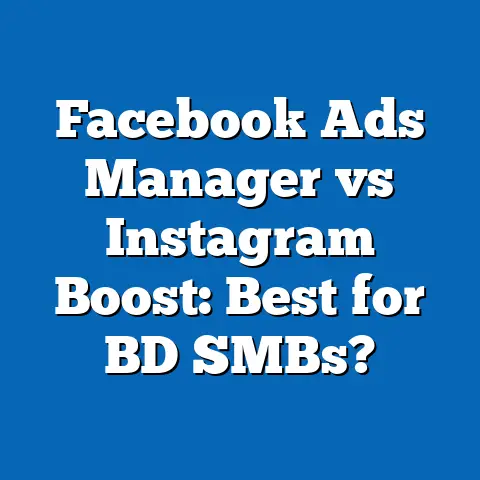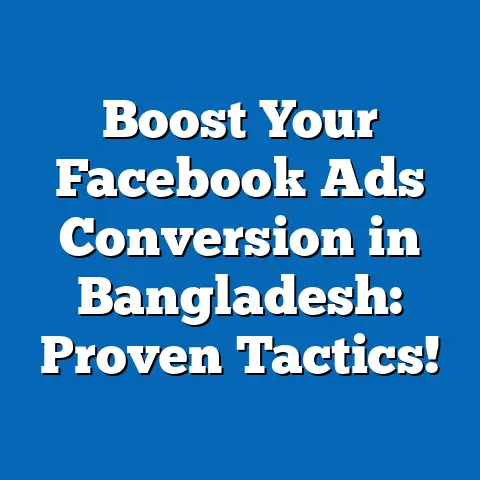Master Facebook Ads A/B Testing in BD for Maximum Impact!
Introduction: Why Facebook Ads A/B Testing is a Game-Changer for Bangladeshi Businesses
When I first ventured into the world of Facebook advertising here in Bangladesh, I was overwhelmed by the number of options and settings in Facebook Ads Manager. The potential seemed limitless, but so did the risk of wasting valuable ad budget. From my early experiences, I quickly understood that without proper testing, running ads was like fishing with a blindfold—you might catch something, but you won’t know why or how to do it again successfully.
A/B testing became my secret weapon. It’s the process of comparing two or more versions of an ad to determine which one performs better based on real data. For small and medium-sized businesses (SMBs) across Bangladesh—especially those in competitive markets like Dhaka, Chittagong, Sylhet, and beyond—this method has been a game-changer.
The local market presents unique challenges: a diverse audience with different languages and dialects, varying levels of internet connectivity, economic sensitivity to pricing, and cultural preferences that influence buying behavior. In this guide, I’ll share everything I’ve learned about mastering Facebook Ads A/B testing tailored to the Bangladeshi digital ecosystem. Whether you’re a small clothing retailer in Rajshahi or a tech startup in Dhaka, this step-by-step guide will help you optimize your campaigns for maximum impact.
Understanding Facebook Ads A/B Testing
What Exactly Is A/B Testing?
A/B testing involves splitting your audience randomly into groups and showing each group a different version of the ad. The goal is to find out which version resonates best with your audience by measuring performance indicators like clicks, conversions, or engagement.
Imagine you are promoting a new smartphone on Facebook in Bangladesh. You could create two ads: one featuring a detailed video review by a popular local influencer and another with a simple image highlighting the phone’s price discount. By running both ads simultaneously and measuring which one gets more purchases or inquiries, you can decide where to put your money next time.
The Psychology Behind A/B Testing
What makes A/B testing so powerful is it removes guesswork. Instead of assuming what your audience prefers, you get direct feedback from actual user behavior. This is crucial in Bangladesh where cultural nuances play a big role in what motivates people to click or buy.
For instance, in my experience working with food delivery startups in Dhaka, ads showing Bengali text with informal conversational language performed better than formal English ads. That insight came only after testing.
Why SMBs in Bangladesh Must Prioritize A/B Testing
Many small businesses here operate on shoestring budgets. Spending BDT 2,000-5,000 daily on Facebook ads can be significant. Without testing, you risk wasting valuable funds on ineffective creatives or targeting.
A/B testing helps you:
- Identify which ads bring the best return on investment (ROI)
- Understand local audience preferences better
- Minimize wasted budget by focusing spend on proven winners
- Adapt quickly to changing market trends, like festival seasons or product launches
Key Metrics to Focus On
To measure success accurately, keep your eyes on these metrics:
| Metric | What It Means | Typical Range in Bangladesh |
|---|---|---|
| CTR (Click-Through Rate) | Percentage who clicked on your ad | 1.5% – 3% |
| CPC (Cost Per Click) | Cost you pay for each click | BDT 5 – 20 |
| CPA (Cost Per Acquisition) | Cost for each conversion (sale, lead) | Varies widely by industry |
| Conversion Rate | Percentage of clicks that convert | 2% – 10% |
| Frequency | How often same user sees your ad | Keep below 3 to avoid fatigue |
| Relevance Score / Quality Ranking | How Facebook rates your ad’s quality and relevance | Higher is better |
Understanding these metrics will allow you to interpret test results and decide which ads to scale.
Setting Up Your First Facebook Ads A/B Test: Step-by-Step
Step 1: Define Clear Campaign Objectives
Before you dive into testing, it’s crucial to set clear objectives aligned with your business goals. Facebook provides various campaign objectives like:
- Brand Awareness
- Traffic (to website or app)
- Engagement (likes, comments)
- Lead Generation
- Conversions (purchases or sign-ups)
In Bangladesh, many SMBs focus on conversions or traffic because they want measurable sales or leads. For example, I helped a local handicraft seller in Khulna choose “Conversions” as their objective with “Add to Cart” as the event to track.
Step 2: Choose the Variable You Want to Test
To get clear insights, test only one variable at a time. Some common variables include:
- Ad Creative: Image vs Video vs Carousel
- Headline: Different wording or offers
- Primary Text: Different descriptions or language style
- Call To Action (CTA): “Shop Now” vs “Learn More”
- Audience: Age groups, interests, locations
- Placement: Facebook Feed vs Instagram Stories vs Audience Network
For example, if you want to test audience targeting for a Dhaka-based restaurant, you could create two ad sets—one targeting ages 18-30 and another 31-45—to see which group responds better.
Step 3: Creating Your Test in Facebook Ads Manager
Here’s a detailed walkthrough:
- Open Facebook Ads Manager: Log in at https://business.facebook.com/adsmanager.
- Click “Create” New Campaign: Pick your objective.
- Enable A/B Test: Look for the “A/B Test” or “Split Test” option.
- Choose Variable: Select what you want to test (e.g., creative).
- Create Variations: Build two or more ad sets or ads with only that variable changed.
- Set Budget and Schedule: I recommend starting with at least BDT 400 per day per ad set for meaningful data.
- Define Audience: Use detailed targeting relevant to your business and location.
- Review and Publish: Double-check all details before launching.
Step 4: Run Your Test and Collect Data
Run your test for at least 3-7 days without interruptions. Short tests may not provide reliable insights due to daily fluctuations in user behavior.
During this time:
- Avoid changing any settings mid-test.
- Monitor results daily but don’t draw conclusions too early.
- Make sure your Pixel or SDK is tracking conversions properly.
Step 5: Analyze Results Using Facebook Reporting Tools
After the test period:
- Go back to Ads Manager and open the “A/B Test” tab.
- Look at key metrics like CTR, CPA, and conversion rate.
- Check if Facebook indicates statistical significance—this tells if results are reliable.
- Identify the winner clearly based on your objective.
For example, I ran an A/B test for a Dhaka-based electronics store where one ad had a video review and another had product images. The video ad had a CTR of 3.2% versus 2% for images, with a conversion rate almost double—this was statistically significant.
Step 6: Scale Winning Ads and Plan Your Next Test
Once you identify the winner:
- Pause or stop losing ads to save budget.
- Gradually increase the budget on winning ads.
- Plan your next test based on new hypotheses (e.g., changing CTA or targeting).
- Keep documenting results for continuous learning.
Deep Dive: Variables You Can Test with Examples from Bangladesh
Testing Ad Creatives: Image vs Video vs Carousel
Visual appeal is critical in Facebook ads here since many users scroll quickly through their feeds.
- Image Ads: Simple and fast loading; good for quick messages.
- Video Ads: More engaging but require good storytelling; mobile-friendly videos perform best.
- Carousel Ads: Showcase multiple products or features; great for e-commerce stores.
Example: For a Dhaka-based jewelry store, I tested image ads with close-ups of necklaces versus carousel ads showing full collections. Carousel ads led to a 22% higher conversion rate during wedding season.
Testing Headlines and Primary Text
Wordings can make a big difference. Use local language variations or popular idioms that resonate with Bangladeshi audiences.
Example: An online grocery store saw a 30% higher CTR when using “দ্রুত অর্ডার করুন” (“Order Fast”) instead of “Order Now” in English.
Testing Call-to-Actions (CTAs)
Different CTAs can drive different behaviors:
- Shop Now
- Learn More
- Sign Up
- Get Offer
Test which CTA aligns best with your campaign goal.
Example: For a tech startup promoting an app in Bangladesh, “Install Now” outperformed “Learn More” by 40% higher installs.
Audience Targeting Tests
Bangladesh is diverse; segmentation by age, gender, location (urban vs rural), language preference (Bengali vs English), income level can reveal insights.
Example: Running separate campaigns targeting Dhaka vs Chittagong showed that users in Chittagong preferred ads with Bengali copy while Dhaka users responded well to English headlines mixed with some Bengali phrases.
Placement Testing: Facebook Feed vs Instagram Stories vs Messenger
Many advertisers overlook placements but choosing where your ads appear can impact results greatly.
According to recent data (2024), over 60% of Bangladeshi Facebook users access via mobile phones with slower networks; therefore:
- Facebook Feed is often more effective than Stories due to ease of viewing.
- Audience Network placements tend to have lower CTR but cheaper CPC.
Leveraging Facebook Pixel for Accurate Conversion Tracking
What Is Facebook Pixel?
Pixel is a small piece of code placed on your website that tracks user actions after clicking your ad—like purchases or sign-ups.
Without Pixel data:
- You can’t accurately measure conversions.
- Your retargeting campaigns will be less effective.
- Lookalike audiences based on customer data won’t work properly.
Setting Up Pixel for Bangladeshi Websites
Many local SMBs use platforms like Shopify Bangladesh versions or WordPress sites. Installing Pixel involves:
- Creating Pixel in Facebook Business Manager.
- Adding Pixel code snippet into website header.
- Setting up standard events like ViewContent, AddToCart, Purchase.
- Testing Pixel via Facebook Pixel Helper Chrome extension.
Using Pixel Data for A/B Testing
Pixel data helps confirm which ad variation drove actual business results—not just clicks but purchases or leads.
Advanced A/B Testing Techniques
Dynamic Creative Testing
Facebook’s Dynamic Creative feature lets you upload multiple images, headlines, and texts; it automatically creates combinations and tests them against each other.
This saves time and uncovers winning combinations without manual setup of multiple ads.
Automated Rules for Campaign Management
Set automated rules in Ads Manager to:
- Pause ads when CPC exceeds BDT 20
- Increase budget by 20% every 3 days if CPA improves
- Notify you when frequency crosses 3 (to avoid ad fatigue)
This helps scale winners efficiently while controlling costs.
Multi-Level Funnel Testing
Test different creative and messaging strategies at each stage of the sales funnel:
- Awareness Stage: Brand storytelling videos
- Consideration Stage: Product feature highlights
- Conversion Stage: Discount offers and urgent CTAs
This ensures relevance at every step and improves overall ROI.
Case Studies from Bangladesh: Real Data Insights
Case Study 1: Apparel Brand in Dhaka Boosting Online Sales During Eid
Objective: Increase online sales during Eid
Tested Variables: Static image vs video showcasing traditional clothes
Budget: BDT 10,000 per day
Results: Video ads had a CTR of 3.5% (vs 2%) and conversion rate of 6% (vs 3%)
Insight: Videos featuring real customers wearing products built trust among urban buyers
Next Steps: Scale video campaigns further with localized copy
Case Study 2: Food Delivery Service Targeting University Students in Sylhet
Objective: Increase app installs
Tested Variables: Bengali language copy vs English language copy
Budget: BDT 5,000 per day
Results: Bengali copy resulted in 25% higher installs and lower CPC (~BDT 12)
Insight: Local language resonates better with youth outside major metro cities
Next Steps: Expand Bengali language campaign across other regions
Case Study 3: Tech Startup Launching New App Feature Nationwide
Objective: Drive sign-ups for beta testing
Tested Variables: CTA buttons – “Sign Up Now” vs “Learn More”
Budget: BDT 8,000 per day
Results: “Sign Up Now” had a conversion rate double that of “Learn More”
Insight: Clear CTAs reduce friction on mobile devices
Next Steps: Combine with retargeting campaigns using Pixel data
Common Pitfalls and How to Avoid Them
Pitfall #1: Testing Too Many Variables at Once
Testing multiple variables simultaneously can confuse results. Stick to one variable per test unless using tools like Dynamic Creative designed for multi-variable testing.
Pitfall #2: Insufficient Budget or Short Test Duration
Low budgets (<BDT 500 per day per variant) or tests shorter than 3 days often produce unreliable data due to statistical noise.
Pitfall #3: Ignoring Local Cultural Contexts
Ads not tailored to local language preferences or cultural events perform poorly. Always incorporate local idioms and seasonal themes into creatives and copy.
Pitfall #4: Overlooking Mobile Optimization
More than 90% of Facebook users in Bangladesh access via smartphones often on slower connections. Ads must be lightweight and visually clear on small screens.
Measuring Success: Benchmarks for Bangladeshi Advertisers
Here are recommended benchmarks based on recent campaigns across various industries:
| Industry | CTR Range | CPC Range (BDT) | CPA Range (BDT) |
|---|---|---|---|
| E-commerce | 2% – 4% | 8 – 15 | 100 – 500 |
| Food & Beverage | 1.8% – 3% | 5 – 12 | 80 – 300 |
| Education & Training | 1.5% – 2.5% | 10 – 20 | 150 – 600 |
| Tech & Apps | 2% – 3.5% | 7 – 18 | Depends on signup value |
Use these benchmarks as guides but always compare against your historical data.
Optimizing Facebook Ads Manager Features for Bangladeshi SMBs
Custom Audiences Based on Website Traffic & Customer Lists
Build custom audiences by uploading customer lists or retargeting website visitors tracked via Pixel. For example, retarget users who added products to cart but didn’t purchase within last 7 days.
Lookalike Audiences from High Value Customers
Create Lookalikes from your best customers who have purchased multiple times or spent more than average order size. This expands reach while maintaining relevance.
Regional Targeting & Language Preferences
Use granular location targeting—for example targeting only Dhaka city wards or Rajshahi district—to reduce wasted spend outside service areas.
Next Steps: Building A Culture of Continuous Improvement through A/B Testing
A/B testing is not a one-time activity; it’s an ongoing process of learning and improving. Here’s how you can embed it into your marketing:
- Set clear monthly goals for tests.
- Document every test result with insights.
- Share learnings with team members.
- Allocate consistent budget for experimentation.
- Use results to inform broader marketing strategy beyond Facebook Ads.
With this approach, Bangladeshi SMBs will not just survive but thrive in an increasingly competitive digital market.
Remember these key points:
- Test one variable at a time for clarity
- Use local language and cultural relevance in creatives
- Monitor important metrics like CTR & CPA closely
- Use Pixel tracking for accurate conversions
- Avoid common pitfalls like short test durations or too many variables
- Continuously scale winners and plan new tests regularly
Start small today; even simple tests can unlock big improvements tomorrow. If you want personalized help analyzing your campaigns or setting up tests optimized for Bangladesh’s market conditions, just reach out anytime!
Happy advertising! Let’s make every taka work harder together.






